Yanjie Fu
Dataforge: A Data Agent Platform for Autonomous Data Engineering
Nov 09, 2025Abstract:The growing demand for AI applications in fields such as materials discovery, molecular modeling, and climate science has made data preparation an important but labor-intensive step. Raw data from diverse sources must be cleaned, normalized, and transformed to become AI-ready, while effective feature transformation and selection are essential for efficient training and inference. To address the challenges of scalability and expertise dependence, we present Data Agent, a fully autonomous system specialized for tabular data. Leveraging large language model (LLM) reasoning and grounded validation, Data Agent automatically performs data cleaning, hierarchical routing, and feature-level optimization through dual feedback loops. It embodies three core principles: automatic, safe, and non-expert friendly, which ensure end-to-end reliability without human supervision. This demo showcases the first practical realization of an autonomous Data Agent, illustrating how raw data can be transformed "From Data to Better Data."
Data-Efficient Symbolic Regression via Foundation Model Distillation
Aug 27, 2025Abstract:Discovering interpretable mathematical equations from observed data (a.k.a. equation discovery or symbolic regression) is a cornerstone of scientific discovery, enabling transparent modeling of physical, biological, and economic systems. While foundation models pre-trained on large-scale equation datasets offer a promising starting point, they often suffer from negative transfer and poor generalization when applied to small, domain-specific datasets. In this paper, we introduce EQUATE (Equation Generation via QUality-Aligned Transfer Embeddings), a data-efficient fine-tuning framework that adapts foundation models for symbolic equation discovery in low-data regimes via distillation. EQUATE combines symbolic-numeric alignment with evaluator-guided embedding optimization, enabling a principled embedding-search-generation paradigm. Our approach reformulates discrete equation search as a continuous optimization task in a shared embedding space, guided by data-equation fitness and simplicity. Experiments across three standard public benchmarks (Feynman, Strogatz, and black-box datasets) demonstrate that EQUATE consistently outperforms state-of-the-art baselines in both accuracy and robustness, while preserving low complexity and fast inference. These results highlight EQUATE as a practical and generalizable solution for data-efficient symbolic regression in foundation model distillation settings.
Distribution Shift Aware Neural Tabular Learning
Aug 27, 2025



Abstract:Tabular learning transforms raw features into optimized spaces for downstream tasks, but its effectiveness deteriorates under distribution shifts between training and testing data. We formalize this challenge as the Distribution Shift Tabular Learning (DSTL) problem and propose a novel Shift-Aware Feature Transformation (SAFT) framework to address it. SAFT reframes tabular learning from a discrete search task into a continuous representation-generation paradigm, enabling differentiable optimization over transformed feature sets. SAFT integrates three mechanisms to ensure robustness: (i) shift-resistant representation via embedding decorrelation and sample reweighting, (ii) flatness-aware generation through suboptimal embedding averaging, and (iii) normalization-based alignment between training and test distributions. Extensive experiments show that SAFT consistently outperforms prior tabular learning methods in terms of robustness, effectiveness, and generalization ability under diverse real-world distribution shifts.
MMTok: Multimodal Coverage Maximization for Efficient Inference of VLMs
Aug 25, 2025Abstract:Vision-Language Models (VLMs) demonstrate impressive performance in understanding visual content with language instruction by converting visual input to vision tokens. However, redundancy in vision tokens results in the degenerated inference efficiency of VLMs. While many algorithms have been proposed to reduce the number of vision tokens, most of them apply only unimodal information (i.e., vision/text) for pruning and ignore the inherent multimodal property of vision-language tasks. Moreover, it lacks a generic criterion that can be applied to different modalities. To mitigate this limitation, in this work, we propose to leverage both vision and text tokens to select informative vision tokens by the criterion of coverage. We first formulate the subset selection problem as a maximum coverage problem. Afterward, a subset of vision tokens is optimized to cover the text tokens and the original set of vision tokens, simultaneously. Finally, a VLM agent can be adopted to further improve the quality of text tokens for guiding vision pruning. The proposed method MMTok is extensively evaluated on benchmark datasets with different VLMs. The comparison illustrates that vision and text information are complementary, and combining multimodal information can surpass the unimodal baseline with a clear margin. Moreover, under the maximum coverage criterion on the POPE dataset, our method achieves a 1.87x speedup while maintaining 98.7% of the original performance on LLaVA-NeXT-13B. Furthermore, with only four vision tokens, it still preserves 87.7% of the original performance on LLaVA-1.5-7B. These results highlight the effectiveness of coverage in token selection.
ISACL: Internal State Analyzer for Copyrighted Training Data Leakage
Aug 25, 2025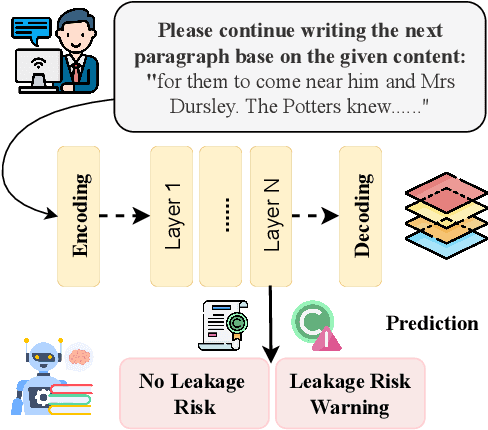
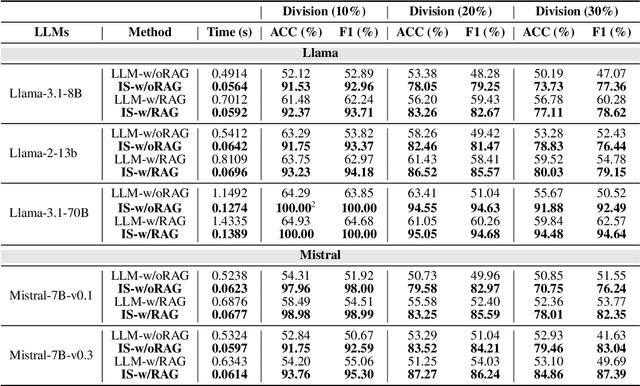
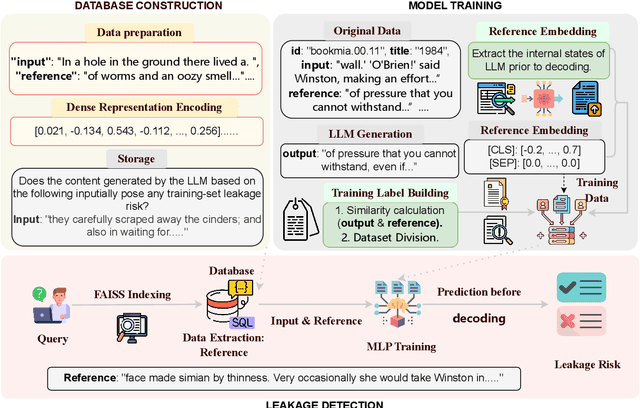
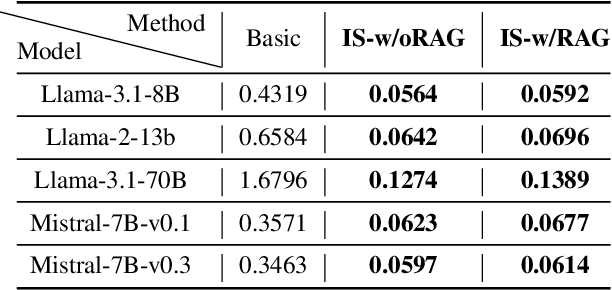
Abstract:Large Language Models (LLMs) have revolutionized Natural Language Processing (NLP) but pose risks of inadvertently exposing copyrighted or proprietary data, especially when such data is used for training but not intended for distribution. Traditional methods address these leaks only after content is generated, which can lead to the exposure of sensitive information. This study introduces a proactive approach: examining LLMs' internal states before text generation to detect potential leaks. By using a curated dataset of copyrighted materials, we trained a neural network classifier to identify risks, allowing for early intervention by stopping the generation process or altering outputs to prevent disclosure. Integrated with a Retrieval-Augmented Generation (RAG) system, this framework ensures adherence to copyright and licensing requirements while enhancing data privacy and ethical standards. Our results show that analyzing internal states effectively mitigates the risk of copyrighted data leakage, offering a scalable solution that fits smoothly into AI workflows, ensuring compliance with copyright regulations while maintaining high-quality text generation. The implementation is available on GitHub.\footnote{https://github.com/changhu73/Internal_states_leakage}
Supply Chain Optimization via Generative Simulation and Iterative Decision Policies
Jul 10, 2025Abstract:High responsiveness and economic efficiency are critical objectives in supply chain transportation, both of which are influenced by strategic decisions on shipping mode. An integrated framework combining an efficient simulator with an intelligent decision-making algorithm can provide an observable, low-risk environment for transportation strategy design. An ideal simulation-decision framework must (1) generalize effectively across various settings, (2) reflect fine-grained transportation dynamics, (3) integrate historical experience with predictive insights, and (4) maintain tight integration between simulation feedback and policy refinement. We propose Sim-to-Dec framework to satisfy these requirements. Specifically, Sim-to-Dec consists of a generative simulation module, which leverages autoregressive modeling to simulate continuous state changes, reducing dependence on handcrafted domain-specific rules and enhancing robustness against data fluctuations; and a history-future dual-aware decision model, refined iteratively through end-to-end optimization with simulator interactions. Extensive experiments conducted on three real-world datasets demonstrate that Sim-to-Dec significantly improves timely delivery rates and profit.
LLM-ML Teaming: Integrated Symbolic Decoding and Gradient Search for Valid and Stable Generative Feature Transformation
Jun 10, 2025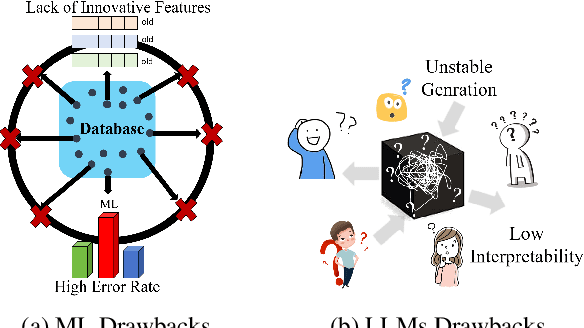

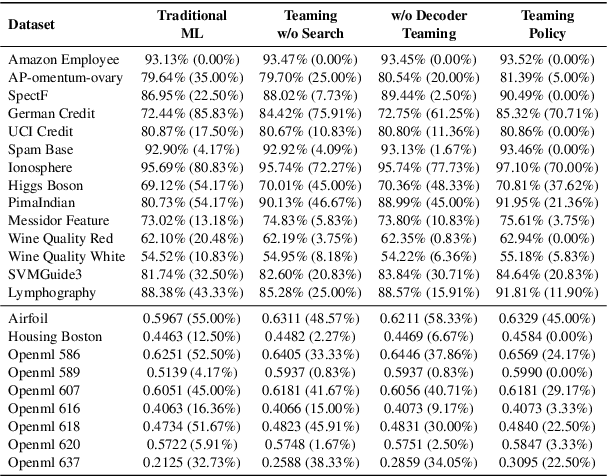
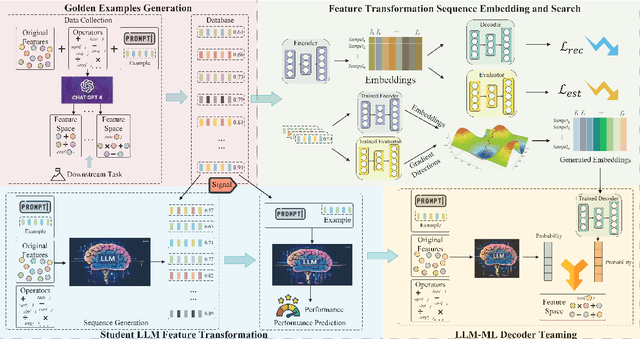
Abstract:Feature transformation enhances data representation by deriving new features from the original data. Generative AI offers potential for this task, but faces challenges in stable generation (consistent outputs) and valid generation (error-free sequences). Existing methods--traditional MLs' low validity and LLMs' instability--fail to resolve both. We find that LLMs ensure valid syntax, while ML's gradient-steered search stabilizes performance. To bridge this gap, we propose a teaming framework combining LLMs' symbolic generation with ML's gradient optimization. This framework includes four steps: (1) golden examples generation, aiming to prepare high-quality samples with the ground knowledge of the teacher LLM; (2) feature transformation sequence embedding and search, intending to uncover potentially superior embeddings within the latent space; (3) student LLM feature transformation, aiming to distill knowledge from the teacher LLM; (4) LLM-ML decoder teaming, dedicating to combine ML and the student LLM probabilities for valid and stable generation. The experiments on various datasets show that the teaming policy can achieve 5\% improvement in downstream performance while reducing nearly half of the error cases. The results also demonstrate the efficiency and robustness of the teaming policy. Additionally, we also have exciting findings on LLMs' capacity to understand the original data.
Enhanced Whole Page Optimization via Mixed-Grained Reward Mechanism-Adapted Language Models
Jun 10, 2025Abstract:Optimizing the presentation of search and recommendation results is crucial to enhancing user experience and engagement. Whole Page Optimization (WPO) plays a pivotal role in this process, as it directly influences how information is surfaced to users. While Pre-trained Large Language Models (LLMs) have demonstrated remarkable capabilities in generating coherent and contextually relevant content, fine-tuning these models for complex tasks like WPO presents challenges. Specifically, the need for extensive human-annotated data to mitigate issues such as hallucinations and model instability can be prohibitively expensive, especially in large-scale systems that interact with millions of items daily. In this work, we address the challenge of fine-tuning LLMs for WPO by using user feedback as the supervision. Unlike manually labeled datasets, user feedback is inherently noisy and less precise. To overcome this, we propose a reward-based fine-tuning approach, PageLLM, which employs a mixed-grained reward mechanism that combines page-level and item-level rewards. The page-level reward evaluates the overall quality and coherence, while the item-level reward focuses on the accuracy and relevance of key recommendations. This dual-reward structure ensures that both the holistic presentation and the critical individual components are optimized. We validate PageLLM on both public and industrial datasets. PageLLM outperforms baselines and achieves a 0.44\% GMV increase in an online A/B test with over 10 million users, demonstrating its real-world impact.
Efficient Post-Training Refinement of Latent Reasoning in Large Language Models
Jun 10, 2025



Abstract:Reasoning is a key component of language understanding in Large Language Models. While Chain-of-Thought prompting enhances performance via explicit intermediate steps, it suffers from sufficient token overhead and a fixed reasoning trajectory, preventing step-wise refinement. Recent advances in latent reasoning address these limitations by refining internal reasoning processes directly in the model's latent space, without producing explicit outputs. However, a key challenge remains: how to effectively update reasoning embeddings during post-training to guide the model toward more accurate solutions. To overcome this challenge, we propose a lightweight post-training framework that refines latent reasoning trajectories using two novel strategies: 1) Contrastive reasoning feedback, which compares reasoning embeddings against strong and weak baselines to infer effective update directions via embedding enhancement; 2) Residual embedding refinement, which stabilizes updates by progressively integrating current and historical gradients, enabling fast yet controlled convergence. Extensive experiments and case studies are conducted on five reasoning benchmarks to demonstrate the effectiveness of the proposed framework. Notably, a 5\% accuracy gain on MathQA without additional training.
Biological Pathway Guided Gene Selection Through Collaborative Reinforcement Learning
May 30, 2025



Abstract:Gene selection in high-dimensional genomic data is essential for understanding disease mechanisms and improving therapeutic outcomes. Traditional feature selection methods effectively identify predictive genes but often ignore complex biological pathways and regulatory networks, leading to unstable and biologically irrelevant signatures. Prior approaches, such as Lasso-based methods and statistical filtering, either focus solely on individual gene-outcome associations or fail to capture pathway-level interactions, presenting a key challenge: how to integrate biological pathway knowledge while maintaining statistical rigor in gene selection? To address this gap, we propose a novel two-stage framework that integrates statistical selection with biological pathway knowledge using multi-agent reinforcement learning (MARL). First, we introduce a pathway-guided pre-filtering strategy that leverages multiple statistical methods alongside KEGG pathway information for initial dimensionality reduction. Next, for refined selection, we model genes as collaborative agents in a MARL framework, where each agent optimizes both predictive power and biological relevance. Our framework incorporates pathway knowledge through Graph Neural Network-based state representations, a reward mechanism combining prediction performance with gene centrality and pathway coverage, and collaborative learning strategies using shared memory and a centralized critic component. Extensive experiments on multiple gene expression datasets demonstrate that our approach significantly improves both prediction accuracy and biological interpretability compared to traditional methods.
 Add to Chrome
Add to Chrome Add to Firefox
Add to Firefox Add to Edge
Add to Edge